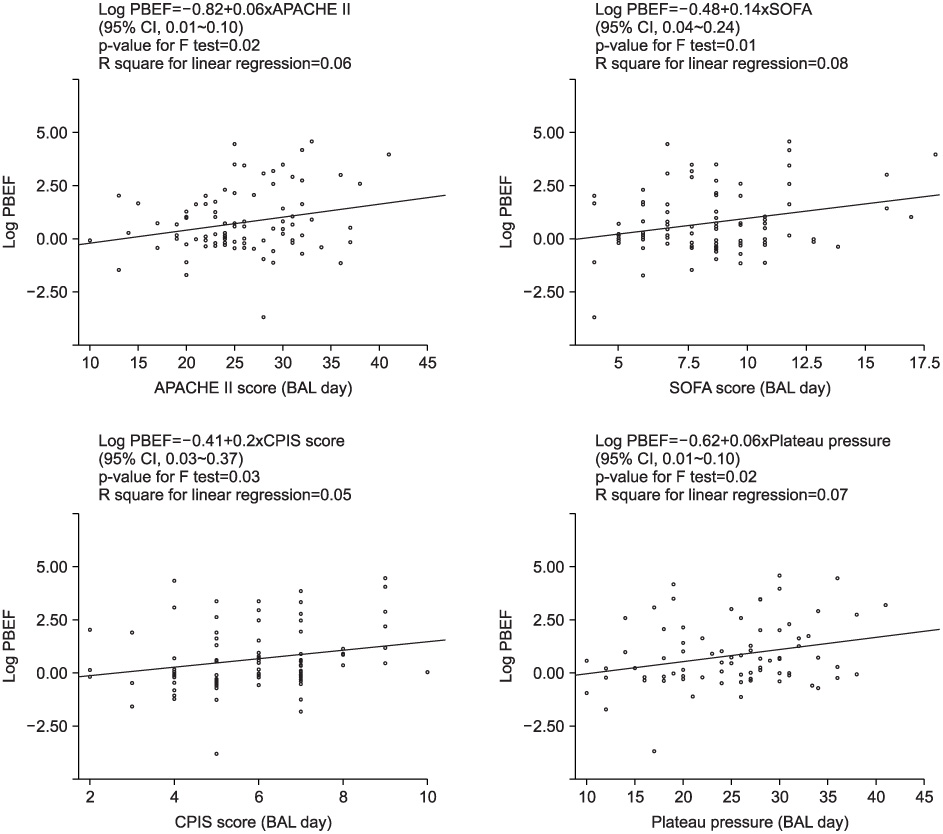Tuberc Respir Dis.
2009 Nov;67(5):402-408.
Clinical Utility of Pre-B-Cell Colony-Enhancing Factor in Bronchoalveolar Lavage Fluid of Acute Critical Ill Patients with Lung Infiltrates
- Affiliations
-
- 1Department of Pulmonary and Critical Care Medicine, Asan Medical Center, University of Ulsan College of Medicine, Seoul, Korea. sbhong@amc.seoul.kr
Abstract
- BACKGROUND
Pre-B-cell colony enhancing factor (PBEF) has been suggested as a novel biomarker in sepsis and acute lung injury. We measured the PBEF in bronchoalveolar lavage (BAL) fluid of acute critically ill patients with lung infiltrates in order to evaluate the clinical utility of measuring PBEF in BAL fluid.
METHODS
BAL fluid was collected by bronchoscope from 185 adult patients with lung infiltrates. An enzyme-linked immunosorbent assay was then performed on the collected fluids to measure the PBEF.
RESULTS
Mean patient age was 59.9+/-14.5 years and 63.8% of patients were males. The mean concentration of PBEF in BAL fluid was 17.5+/-88.3 ng/mL, and patients with more than 9 ng/mL of PBEF concentration (n=26, 14.1%) had higher Acute Physiology and Chronic Health Evaluation (APACHE) II and Sequential Organ Failure Assessment (SOFA) scores on the BAL exam day. However, there were no significant differences in clinical characteristics between survivors and non-survivors. In patients with leukocytosis (n=93) seen on the BAL exam day, the linear regression analysis revealed a significant, positive relationship between PBEF and APACHE II (r2=0.06), SOFA score (r2=0.08), Clinical Pulmonary Infection Score (r2=0.05), and plateau pressure in patients on ventilators (r2=0.07) (p<0.05, respectively). In addition, multivariate regression analysis with PBEF as a dependent variable showed that the plateau pressure (r2=0.177, p<0.05) was correlated positively with PBEF.
CONCLUSION
The PBEF level in the BAL fluid may be a useful, new biomarker for predicting the severity of illness and ventilator-induced lung injury in critically ill patients with lung infiltates and leukocytosis.
Keyword
MeSH Terms
-
Acute Lung Injury
Adult
APACHE
Bronchoalveolar Lavage
Bronchoalveolar Lavage Fluid
Bronchoscopes
Critical Illness
Enzyme-Linked Immunosorbent Assay
Humans
Leukocytosis
Linear Models
Lung
Lung Diseases
Male
Nicotinamide Phosphoribosyltransferase
Precursor Cells, B-Lymphoid
Sepsis
Survivors
Ventilator-Induced Lung Injury
Ventilators, Mechanical
Nicotinamide Phosphoribosyltransferase
Figure
Reference
-
1. Samal B, Sun Y, Stearns G, Xie C, Suggs S, McNiece I. Cloning and characterization of the cDNA encoding a novel human pre-B-cell colony-enhancing factor. Mol Cell Biol. 1994. 14:1431–1437.2. Fukuhara A, Matsuda M, Nishizawa M, Segawa K, Tanaka M, Kishimoto K, et al. Visfatin: a protein secreted by visceral fat that mimics the effects of insulin. Science. 2005. 307:426–430.3. López-Bermejo A, Chico-Julià B, Fernàndez-Balsells M, Recasens M, Esteve E, Casamitjana R, et al. Serum visfatin increases with progressive beta-cell deterioration. Diabetes. 2006. 55:2871–2875.4. Chen MP, Chung FM, Chang DM, Tsai JC, Huang HF, Shin SJ, et al. Elevated plasma level of visfatin/pre-B cell colony-enhancing factor in patients with type 2 diabetes mellitus. J Clin Endocrinol Metab. 2006. 91:295–299.5. Jia SH, Li Y, Parodo J, Kapus A, Fan L, Rotstein OD, et al. Pre-B cell colony-enhancing factor inhibits neutrophil apoptosis in experimental inflammation and clinical sepsis. J Clin Invest. 2004. 113:1318–1327.6. Ye SQ, Simon BA, Maloney JP, Zambelli-Weiner A, Gao L, Grant A, et al. Pre-B-cell colony-enhancing factor as a potential novel biomarker in acute lung injury. Am J Respir Crit Care Med. 2005. 171:361–370.7. Bajwa EK, Yu CL, Gong MN, Thompson BT, Christiani DC. Pre-B-cell colony-enhancing factor gene polymorphisms and risk of acute respiratory distress syndrome. Crit Care Med. 2007. 35:1290–1295.8. Hong SB, Huang Y, Moreno-Vinasco L, Sammani S, Moitra J, Barnard JW, et al. Essential role of pre-B-cell colony enhancing factor in ventilator-induced lung injury. Am J Respir Crit Care Med. 2008. 178:605–617.9. Jimenez MF, Watson RW, Parodo J, Evans D, Foster D, Steinberg M, et al. Dysregulated expression of neutrophil apoptosis in the systemic inflammatory response syndrome. Arch Surg. 1997. 132:1263–1269. discussion 1269-70.10. Taneja R, Parodo J, Jia SH, Kapus A, Rotstein OD, Marshall JC. Delayed neutrophil apoptosis in sepsis is associated with maintenance of mitochondrial transmembrane potential and reduced caspase-9 activity. Crit Care Med. 2004. 32:1460–1469.11. Lee WL, Downey GP. Leukocyte elastase: physiological functions and role in acute lung injury. Am J Respir Crit Care Med. 2001. 164:896–904.
- Full Text Links
- Actions
-
Cited
- CITED
-
- Close
- Share
- Similar articles
-
- The bronchoalveolar lavage fluid cell analysis with normal lung and unaffected side lung of patients with minor symptoms or radiologic abnormalities
- Acute Eosinophilic Pneumonia: A Case Report
- Changes of the cellularities in the bronchoalveolar lavage fluid of the experimental silicosis
- Correspondence Regarding the Article Titled “Low Lymphocyte Proportion in Bronchoalveolar Lavage Fluid as a Risk Factor Associated with the Change from Trimethoprim/sulfamethoxazole Used as First-Line Treatment for Pneumocystis jirovecii Pneumonia”
- Endothelin-l Content of Bronchoalveolar Lavage in Allografted Lungs during Acute Rejection



